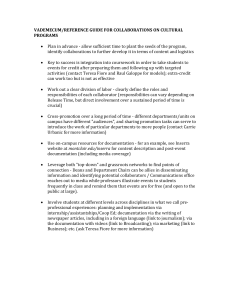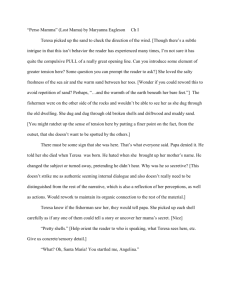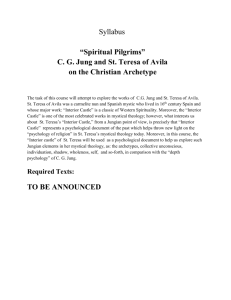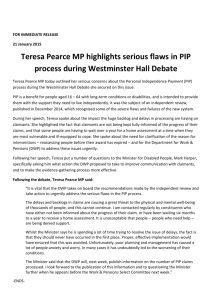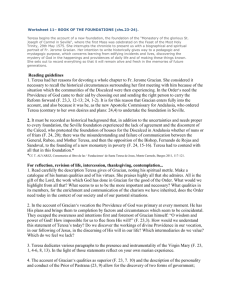Worksheet 10
advertisement
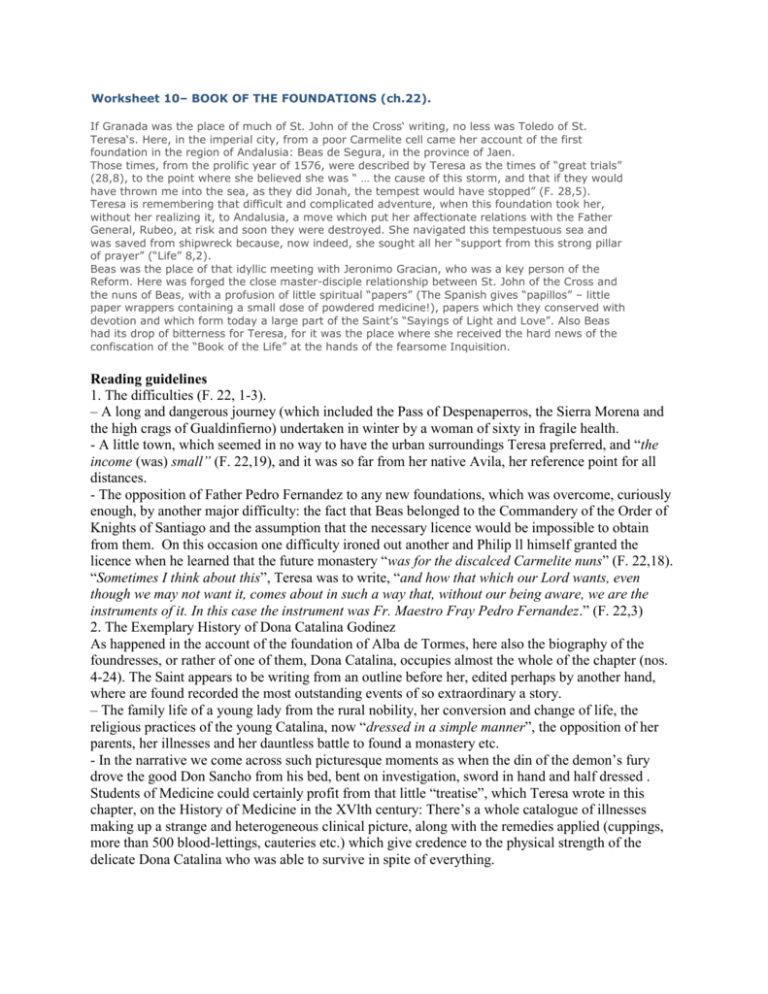
Worksheet 10– BOOK OF THE FOUNDATIONS (ch.22). If Granada was the place of much of St. John of the Cross‘ writing, no less was Toledo of St. Teresa‘s. Here, in the imperial city, from a poor Carmelite cell came her account of the first foundation in the region of Andalusia: Beas de Segura, in the province of Jaen. Those times, from the prolific year of 1576, were described by Teresa as the times of “great trials” (28,8), to the point where she believed she was “ … the cause of this storm, and that if they would have thrown me into the sea, as they did Jonah, the tempest would have stopped” (F. 28,5). Teresa is remembering that difficult and complicated adventure, when this foundation took her, without her realizing it, to Andalusia, a move which put her affectionate relations with the Father General, Rubeo, at risk and soon they were destroyed. She navigated this tempestuous sea and was saved from shipwreck because, now indeed, she sought all her “support from this strong pillar of prayer” (“Life” 8,2). Beas was the place of that idyllic meeting with Jeronimo Gracian, who was a key person of the Reform. Here was forged the close master-disciple relationship between St. John of the Cross and the nuns of Beas, with a profusion of little spiritual “papers” (The Spanish gives “papillos” – little paper wrappers containing a small dose of powdered medicine!), papers which they conserved with devotion and which form today a large part of the Saint’s “Sayings of Light and Love”. Also Beas had its drop of bitterness for Teresa, for it was the place where she received the hard news of the confiscation of the “Book of the Life” at the hands of the fearsome Inquisition. Reading guidelines 1. The difficulties (F. 22, 1-3). – A long and dangerous journey (which included the Pass of Despenaperros, the Sierra Morena and the high crags of Gualdinfierno) undertaken in winter by a woman of sixty in fragile health. - A little town, which seemed in no way to have the urban surroundings Teresa preferred, and “the income (was) small” (F. 22,19), and it was so far from her native Avila, her reference point for all distances. - The opposition of Father Pedro Fernandez to any new foundations, which was overcome, curiously enough, by another major difficulty: the fact that Beas belonged to the Commandery of the Order of Knights of Santiago and the assumption that the necessary licence would be impossible to obtain from them. On this occasion one difficulty ironed out another and Philip ll himself granted the licence when he learned that the future monastery “was for the discalced Carmelite nuns” (F. 22,18). “Sometimes I think about this”, Teresa was to write, “and how that which our Lord wants, even though we may not want it, comes about in such a way that, without our being aware, we are the instruments of it. In this case the instrument was Fr. Maestro Fray Pedro Fernandez.” (F. 22,3) 2. The Exemplary History of Dona Catalina Godinez As happened in the account of the foundation of Alba de Tormes, here also the biography of the foundresses, or rather of one of them, Dona Catalina, occupies almost the whole of the chapter (nos. 4-24). The Saint appears to be writing from an outline before her, edited perhaps by another hand, where are found recorded the most outstanding events of so extraordinary a story. – The family life of a young lady from the rural nobility, her conversion and change of life, the religious practices of the young Catalina, now “dressed in a simple manner”, the opposition of her parents, her illnesses and her dauntless battle to found a monastery etc. - In the narrative we come across such picturesque moments as when the din of the demon’s fury drove the good Don Sancho from his bed, bent on investigation, sword in hand and half dressed . Students of Medicine could certainly profit from that little “treatise”, which Teresa wrote in this chapter, on the History of Medicine in the XVlth century: There’s a whole catalogue of illnesses making up a strange and heterogeneous clinical picture, along with the remedies applied (cuppings, more than 500 blood-lettings, cauteries etc.) which give credence to the physical strength of the delicate Dona Catalina who was able to survive in spite of everything. - The key to this singular and entertaining history is found in n. 6, with Teresa writing: “so that all might praise Him”, God, for sure, the true protagonist of this book. It is for this reason that we find in n. 7 a fine and deeply moving prayer, which rests on the Gospel: “May You be blessed for ever and ever, my God, for within a moment You undo a soul and remake it…” 3. The “Actual” History of the foundation (F. 22, 19-20) Hardly two numbers are dedicated to the account of the actual founding, so brief that they simply refer to the year, 1575, when the nuns led by Teresa arrived “at the beginning of Lent”, allude to the joy of the town, give the name of the new monastery (St. Joseph of the Saviour, founded on the feast of St Matthias) and make a brief mention of the two sisters, the foundresses, receiving the habit, this final detail being embellished with new praises of the matchless Catalina. And finally! “What His Majesty desires cannot be set aside” (F. 22,19). 4. Appendix (F. 22, 21-24) The account appears to be finished at the final phrase of n. 20, but then Teresa adds a kind of appendix in which we find: - The “supernatural” way in which Catalina came to know of the existence of the Order of Carmel and of its Rule, as also her meeting the Jesuit who told her he “knew of these monasteries” (F. 22, 21-22). - New details of the miraculous cure (F. 22,23). - Virtues of Dona Catalina, now become Catalina of Jesus, of whom Teresa powerfully draws a magisterial portrait: “I don’t know anything about this soul that does not have to do with her trying to be more pleasing to God, and all the nuns feel the same way.” (F. 22, 24) The proof that none of this, as the Saint said, “ was exaggerated” exists in the testimony left by Gracian in his Peregrination of Anastasio, dialogue 16, for there he wrote that Mother Catalina is one of the greatest saints of the Order. Further, St. John of the Cross himself undertook, in his own hand, the transcription of the text of her autobiography. - And now, really, we have the Amen! For reflection, revision of life, intercession, thanksgiving, contemplation… 1. Read and meditate on the conversion of Catalina Godinez before the crucifix (F. 22, 5-6), comparing it with “Life” 9, 1-3, where Teresa of Jesus tells us of her own conversion before an image of the gravely lacerated Christ. 2. This could be a good moment for thinking about and sharing with the group your encounter with Jesus and how it changed your life. 3. Pray with Teresa, bless and praise our Lord. (F. 22, 7). 4. “For I hold that our Lord never grants so great a favour to a person without allowing others to share in it as well” (F. 22, 9). This interdependence of the members of the Mystical Body of Christ is noted many times by Teresa of Jesus in various texts (4M 3, 10; 5M 4, 6, among others). None of us goes alone by the chosen way; for good or ill we draw others after us. - Are we conscious of this truth, which is a very serious responsibility? - Perhaps the post-modern individualism, from which we all suffer, leads us to forget the power of Christian witness. St. Paul said that we must all carry one another’s burdens. - Could we also come to be “contaminated”, almost without realising it, with the secularist tendency, which sets out to impose itself, according to which faith has to be lived within private and strictly personal boundaries? - Is my prayer, more or less, subtly confined to my own intimate interests? Remember that “This is the reason for prayer… the purpose of this spiritual marriage: the birth always of good works, good works” (7M 4,6). - Pray once again with Teresa using “Accounts of Conscience” (CC ) 1 n. 14, i.e. “Spiritual Testimonies” (in Kavanaugh- Rodriguez) 1 no.14; and “Life” 16, 6-7. Share your prayer on these texts with the community, parish or prayer groups etc. 5. Lastly an entreaty: “May it please His Majesty that the extraordinary generosity He has shown this miserable sinner serve to encourage and rouse those who read this to abandon completely everything for God.” (“Life” 21,12).
